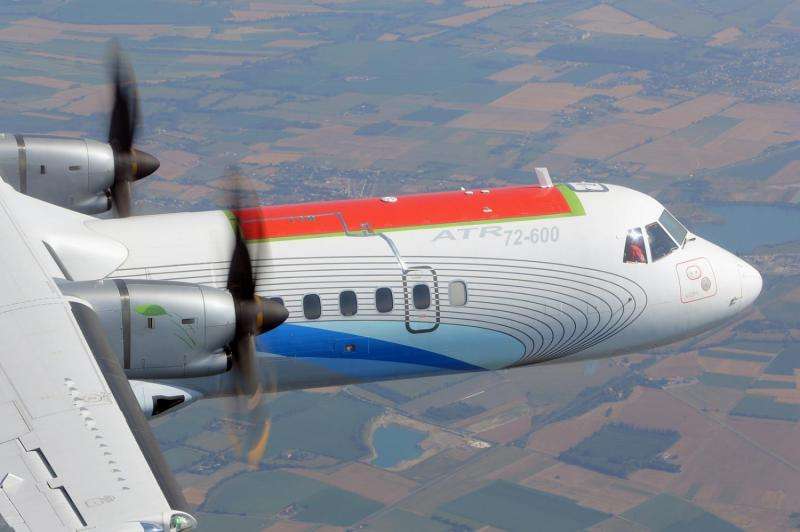Behavior of carbon fiber reinforced plastics during flights verified precisely

Little is known as yet about the behavior of carbon fiber reinforced plastics (CFRP) during a flight. As part of the Clean Sky research initiative and with the help of a measurement configuration based on fiber optics, Fraunhofer researchers have accurately verified the degree to which CFRP parts deform during flight.
The pilots starts his takeoff. The tires slowly leave the asphalt. On board: No passengers, not even rows of seats. The paneling of the interior walls is missing: instead, there are cables, sensors, and measurement equipment which are screwed to the floor. The fuselage of the plane is not made of aluminum, as would usually be the case. A component made of carbon fiber reinforced plastic (CFRP) forms the upper fuselage – from the cockpit to the wings. Lightweight yet stable. The material of the future. It is certain that it will withstand the stress of the test flight. But to what degree will it deform during different flight maneuvers? Exact values had not yet been known.
Nanometer precision
"CFRP structures behave differently during a flight to those made of aluminum," says Conchin Contell Asins, scientist at the Fraunhofer Institute for Structural Durability and System Reliability LBF in Darmstadt. She and her colleague Oliver Schwarzhaupt determined exactly how this happens by using a special test setup during the test flights. With the help of fiber optic technology, optical measuring fibers detected even minimal deformations. "That's not possible with conventional metallic strain gauges. These are based on changes in their electrical resistance by deformation, but their resolution is not as fine," the researcher explains.
The aim of the measurement flights was to obtain solid data that can be compared with the theoretical calculations of the flight behavior of CFRP. The real data require aircraft manufacturers to build components so precisely that they can withstand the stresses that occur in the respective aircraft model. This has so far only been possible by approximation. Therefore, aircraft manufacturers are integrating CFRP overdimensioned in new models, as a precaution. "The test flights have shown that our test setup works: We have been able to assign a unique CFRP deformation to each flight maneuver. The values were so accurate that conclusions could have also been reached about the flight profile based upon the strain signals," Schwarzhaupt adds. It is also possible with this system to monitor the structure for its condition during the flight. "A change in the deformation behavior might indicate damage. With such a monitoring of the structure, components could remain in use for much longer," Contell Asins says.
In the test flight, the team of scientists from Darmstadt installed the complete measurement hardware in the plane and evaluated the data. The aircraft manufacturer analyzes the results in "JTI Clean Sky– Green Regional Aircraft Platform" of the 7th Framework Program, a research initiative of the European Commission and the European aviation industry. The goal: to build even lighter CFRP components and to increase the operating time of the components. Schwarzhaupt: "Saving on unnecessary material means needing less fuel".
Most heavily stressed component tested
The test aircraft was a medium-range model for about 70 passengers. For flights, a CFRP component which was about five-by-three-meters long was used. This area is one of the most heavily stressed components during flight. The researchers applied the optical measuring fibers on the side facing the aircraft interior. "The thin, elongated glass fibers are well suited to display even very weak changes of larger components," Contell Asins says.
An optical-electrical evaluation unit recorded the signals of the measuring fibers. The black box provided additional information about the altitude, airspeed or flight maneuvers. "We have correlated both data pools – strain measurements and flight data – with the help of special software," Contell Asins explains. To attach the strain sensors to the right places, the researchers had to know where stress typically occurs during flight maneuvers. "We were able to bring in our expertise about the behavior of CFRP: We had previously calculated the sites with the highest degree of stress and attached the measuring points there," says Schwarzhaupt. In CFRP structures in aircraft, the attached stiffeners primarily bear the stress. These are located on the inside of the hull in the longitudinal and circumferential direction of the fuselage.
How CFRP behaves in the air
Due to the lower air pressure, the fuselage expands during the flight. In part by a few centimeters. If this happens too much, cracks can occur. CFRP tolerates stretching of up to 1.5 % of its original length before breaking. That doesn't sound like much. But in order for CFRP to stretch so much, the forces have to be much higher than in the case of aluminum. Optical measuring fibers are able to show changes as small as a few nanometers.
Provided by Fraunhofer-Gesellschaft




















